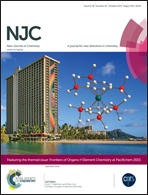A facile photoluminescence modulated nanosensor based on nitrogen-doped graphene quantum dots for sulfite detection
Abstract
In this work, a facile photoluminescence (PL) modulated nanosensor was designed for sulfite detection. The nanosensor was based on the different quenching effects of Fe3+ and Fe2+ on the PL intensity of nitrogen-doped graphene quantum dots (N-GQDs). Firstly, the PL of N-GQDs was quenched with the addition of Fe3+ due to the strong selective coordination between the N-GQDs and Fe3+. At the PL recovery step, Fe3+ can be transformed to Fe2+ with the addition of sulfite. Because Fe2+ had no apparent quenching effect on N-GQDs, the PL signal of N-GQDs can be enhanced largely. Under optimal conditions, the PL of N-GQDs displayed a good linear relationship versus the concentration of sulfite in the range of 4.0–200.0 μM. The limit of detection was 1.43 μM. This was the first time that sulfite detection had been based on the PL modulation of N-GQDs. The proposed method was facile, sensitive and fast for sulfite detection with simple operation and materials and sulfite in real water samples was successfully detected with satisfactory results. Furthermore, the sensing application range of N-GQDs has been extended based on this novel concept.


 Please wait while we load your content...
Please wait while we load your content...